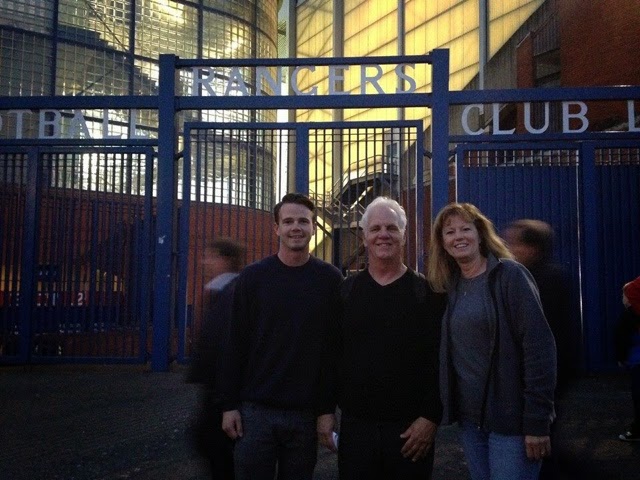Above, the street vendors all set up. We snacked at many of them... And below, mom and dad caught mid-bite.
Big Ben was nearby and of course, a must-see. Known officially as the Elizabeth Tower, Big Ben is actually the nickname for the Great Bell, the huge bell inside the tower but by extension, the whole tower seems to have adopted the name.
The tower is part of the greater Palace of Westminster, which originally housed the royal family when it was built some five hundred years ago. Today, it is home to the British Parliament. Across the street from the palace, is Westminster Abbey, where coronations and royal funerals have taken place for nearly 1000 years! Despite its historical significance, I somehow managed to have zero photos of it...
Somewhere in our blur of London sightseeing we took a river cruise on the River Thames, which runs through the city center. Along the river are many bridges, including the London Bridge, made famous by the old children's song. I have to say, London Bridge was pretty underwhelming to look at and appeared to be nothing more than an ordinary concrete bridge. The bridge does have a long history beginning with its Roman origins around the time of Christ. Apparently, the builders of the modern design, built in 1973, decided not to pay an homage to its storied past...
Above, under the London Bridge and below, the Gate Bridge, several hundred yards down the river. In my opinion, a much more beautiful bridge.
Enough of making fun of the London Bridge, we moved on to check out the Tower of London, a historic castle situated on the edge of the River Thames. Founded in 1066, the castle is a collection of towers and buildings constructed over several centuries. From the beginning, the castle was a symbol of oppression as one of its earliest occupants was William the Conquerer, who based on his nickname alone doesn't sound like a particular benevolent leader. Later the castle was used a prison and sometimes execution area, though the actually number of executions held here has been greatly exaggerated in history. More commonly, prominent figures that had fallen out of favor were held here in a relatively nicer prison than enjoyed by commoners. Today, some of the graffiti left by the prisons historical "guests" can still be found on the walls.
Above, the Tower of London, which is in fact not a tower at all. We were lucky enough to be there for the commemoration of the end of World War I, thus all the incredible flowers. The castle is now home to many museums and a bitchin collection of royal armor collected over hundreds of years. Impressive stuff! Can't imagine having someone suited like that charging at me with a club and sword...
The more modern side of London is a miles long strip of shopping and restaurants. It was amazing how many people were flooded in the streets for blocks and blocks on end. I haven't been to New York in many years but I would imagine the crowds are very similar. London even had a huge plaza with flashing billboards and TVs that would've been very reminiscent of Times Square.
Above, the famous double decker busses of London and below, the best photo I could muster that captured some of the bustling streets... As usual, photos don't do it justice.
Not all of London is historic, above is a modern take on an old city. As with most major cities and especially in Europe, space is at a premium. We had a beautiful hotel but our room was pretty cramped, especially compared with Scotland. I could almost play footsie with my parent laying down in my narrow pull-out bed...
Below, our hotel...
At some point in history, London has been the capital of most parts of the world as the British had colonies all over every continent. To see a map of former British territory is actually pretty fascinating and eye-opening. Despite losing its hold on much of its former colonies, London was and is still a music capital of the world, producing such bands as The Rolling Stones, The Who, Cat Stevens and more recently, Coldplay and Florence and the Machine. One street in London, lined with studios, music shops and live venues, seems to have given start to a staggering high number of these famous musicians. We stumbled upon the street and found the building where Elton John "sat on the roof and kicked off the moss" while producing a few of his biggest hits.
In walking so many miles around London, you see museums and churches and buildings that you can't even remember what they are. Below, mom and dad pose in front a couple of buildings I should know the names of...
After running ragged with my parents for the last two weeks, it came to end my wayward wandering and head back to the United States. Spending time with my parents on their first ever trip to Europe was definitely one of the best highlights from my nearly six months of living from a small suitcase.
There's no way to recollect all the memories and places I was fortunate enough to experience and I am so grateful for the chance to have seen so much of the world. It's hard to know exactly how to end the blog - or at least this chapter of it - especially without getting too sappy, so I'll end with this; if you're thinking about taking such a trip, do it! It has been the best decision of my life.
25 pounds lighter and all pearly whites on my way to London Heathrow for the flight home!

















































